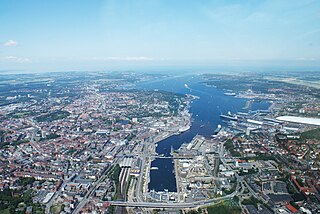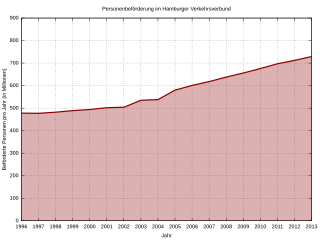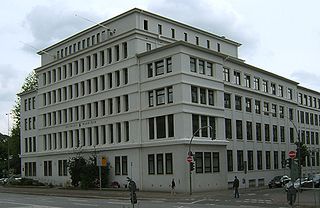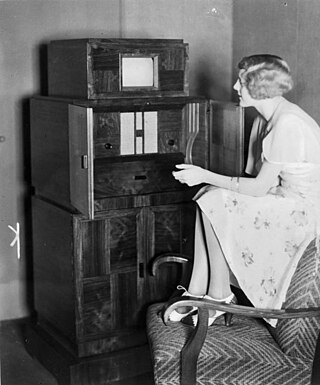
Kiel is the capital and most populous city in the northern German state of Schleswig-Holstein, with a population of 246,243 (2021).

The Hamburg Metropolitan Region is a metropolitan area centred around the city of Hamburg in northern Germany, consisting of eight districts in the federal state of Lower Saxony, six districts in the state of Schleswig-Holstein and two districts in the state of Mecklenburg-Vorpommern along with the city-state of Hamburg itself. It covers an area of roughly 26,000 square kilometres (10,000 sq mi) and is home to more than 5.1 million inhabitants.

The Hamburger Verkehrsverbund (HVV) is a transport association coordinating public transport in and around Hamburg, Germany. Its main objectives are to provide a unified fare system, requiring only a single ticket for journeys with transfers between different operating companies, and to facilitate and speed up travel by harmonising the individual companies' schedules. At its inception in 1965, the HVV was the first organisation of its kind worldwide.
Television in Germany began in Berlin on 22 March 1935, broadcasting for 90 minutes three times a week. It was home to the first regular television service in the world, named Fernsehsender Paul Nipkow.

Norddeutscher Rundfunk, commonly shortened to NDR, is a public radio and television broadcaster, based in Hamburg. In addition to the city-state of Hamburg, NDR broadcasts for the German states of Lower Saxony, Mecklenburg-Vorpommern and Schleswig-Holstein. NDR is a member of the ARD organisation.

Wandsbek is the second-largest of seven boroughs that make up the city and state of Hamburg, Germany. The name of the district is derived from the river Wandse which passes through here. Wandsbek, which was formerly an independent city, is urban and, along with Eilbek and Marienthal, part of the city's economic and cultural core. In 2020 the population was 442,702, making it the most populous borough in Hamburg.

Nordwestdeutscher Rundfunk was the organization responsible for public broadcasting in the German Länder of Hamburg, Lower Saxony, Schleswig-Holstein and North Rhine-Westphalia from 22 September 1945 to 31 December 1955. Until 1954, it was also responsible for broadcasting in West Berlin. NWDR was a founder member of the consortium of public-law broadcasting institutions of the Federal Republic of Germany, the ARD.

Niendorf is one of 105 quarters of Hamburg, Germany in the Eimsbüttel borough. In 2020 the population was 40,906.

Finkenwerder is a quarter of Hamburg, Germany in the borough Hamburg-Mitte. It is the location of the Hamburg Airbus plant and its airport. In 2016 the population was 11,668.

NDR Fernsehen is a German free-to-air regional television channel targeting northern Germany, specifically the states of Schleswig-Holstein, Lower Saxony, Mecklenburg-Vorpommern, Hamburg and Bremen.

Witzhave is a municipality in the district of Stormarn, in Schleswig-Holstein, Germany.

St. Georg is a central quarter in the borough Hamburg-Mitte of Hamburg, Germany. In 2020 the population was 11,349.

Blankenese is a suburban quarter in the borough of Altona in the western part of Hamburg, Germany; until 1938 it was an independent municipality in Holstein. It is located on the right bank of the Elbe river. With a population of 13,637 as of 2020, today it is widely known as one of Hamburg's most affluent neighborhoods.

Hamburg-Mitte is one of the seven boroughs of Hamburg, Germany, covering most of the city's urban center. The quarters of Hamburg-Altstadt and Neustadt cover much of the city's historic core. In 2020 the population was 301,231.

89.0 RTL is a German radio channel whose studios are located in Halle (Saale). It aims at the 14-29 age bracket.

The first regular electronic television service in Germany began in Berlin on March 22, 1935, as Deutscher Fernseh Rundfunk. Broadcasting from the Fernsehsender Paul Nipkow, it used a 180-line system, and was on air for 90 minutes, three times a week. Very few receivers were ever privately owned, and viewers went instead to Fernsehstuben. During the 1936 Summer Olympics, broadcasts, up to eight hours a day, took place in Berlin and Hamburg. The Nazis intended to use television as a medium for their propaganda once the number of television sets was increased, but television was able initially to reach only a small number of viewers, in contrast to radio. Despite many technical improvements to camera technology, allowing for higher resolution imaging, by 1939, and the start of World War II, plans for an expansion of television programming were soon changed in favor of radio. The production of the TV receiver E1, that had just started was cancelled because of the war. Nevertheless, the Berlin station, along with one in occupied Paris, remained on the air for most of World War II. A special magazine called Fernsehen und Tonfilm was published.

Klassik Radio is a radio station in Germany. It specialises in classical music, Film music and Lounge music. The channel is receivable in over 300 German cities via FM, throughout Germany via cable, and in Europe via satellite. It is also worldwide streamed on the internet. At the start of the new national DAB standard DAB+ on 1 August 2011 Klassik Radio gained an additional technical range of 53.5 million households in the whole country. Klassik Radio is a subsidiary company of Klassik Radio Inc. located in Augsburg. The broadcasting centre is based in Hamburg.

Markus Lanz is a German-Italian television presenter based in Germany.
Schleswig-Holsteinischer Zeitungsverlag, sh:z, is a newspaper group based in Flensburg, Schleswig-Holstein. With 22 daily newspapers, the group is the largest daily publisher in the state. sh:z's publications have a circulation of over 150,000 with readership of about half a million people. The website SHZ.de carries news stories from the group's newspapers.


















